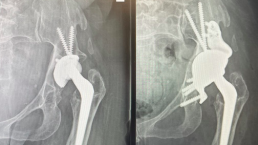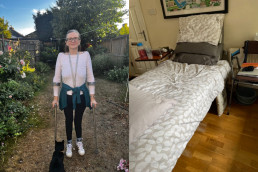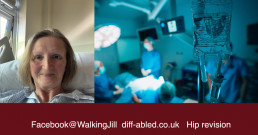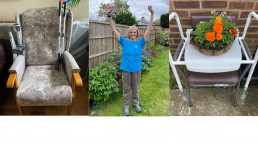Before and after hip xray: hip replacement to hip revision
So here is my new hip! With a handy before (hip replacement) and after (hip revision) comparison Xray. First thing that strikes me is that there’s a lot more metal than pelvis now. Due to my hip dysplasia, I’ve never had much pelvis on that side (which was the difficulty with getting my childhood reduction surgeries to stick). The challenge for the hip revision was to extend the socket and so that bit you can see on the right hand side of the Xray is the custom 3D printed metal socket doing just that job.
I was talking to a friend a few weeks ago about the fact that I was finding it difficult to visualise my new hip because I hadn’t yet seen an Xray. And in that conversation it became clear how much I understand my condition through the hip Xrays I’ve had through my life. I have never not had a mental image of what my pelvis and hips look like and I suspect that’s the same for anyone diagnosed with CDH at birth. And so I suddenly felt lost. Now, I ‘get it’. I can see what my orthopaedic surgeon has done and I can finally connect the image with how it feels. It’s reassuring to me.
The last few weeks have been very boring. I’ve been diligent and consistent with my physio exercises, and maintaining all the restrictions around precaution height and restricted movements. For the last 3 weeks I have at least been able to go for longer walks on my crutches, but I still can’t go anywhere where I need to sit.
I saw my Xray when I had my 6 weeks post-op check up this week with my orthopaedic consultant. He seemed pleased with my progress - wound is healed well, no infections, no thrombosis, nerves appear to be undamaged and the leg is “pointing in the right direction”. He was also happy that I’m taking things slow and steady - something he wants me to continue for the next 7 weeks. I am still to stay on crutches as by far the biggest risk is falling. As he said, in essence it’s like having a big fracture in my pelvis and that needs caution. I guess if I fall and damage this, there’s no more pelvis to play with, and now I’ve seen the Xray my brain gets that so much more.
So it’s more of mostly the same.
- I asked if I can swim yet, we compromised on me adding supervised hydrotherapy into the mix, as long as I take it carefully.
- Continue with the physio with the advice of take it slowly and carefully.
- I can however start to play with lowering the precaution height of chairs very gradually - eg removing one of the three cushion - as long as I never bend more than 90 degrees. As this progresses it will give me a little more freedom to at least walk further if I can sit on a bench or in a cafe to rest half way.
- Still no bending, twisting or climbing into the over-bath shower though….so still the strip wash regime continues into September. At least when I go for hydrotherapy I’ll be able to have a shower afterwards - can’t decide if I’m more excited about getting in the pool or having the shower!!
If I'm honest, I had mixed feelings after my appointment. Obviously the overriding positive feeling is that I’m progressing well in his expert eyes, and that surgically he is considering this a success. But I also had a feeling of dashed hopes. Hopes that I could start to do more, more quickly - particularly swimming or driving, which would give me more independence.
But this is not my first surgery and I know that by sticking to what I’m asked to do, the end result will be more positive. This too shall pass. And my independence day will come :-)
Meanwhile, stay tuned, thanks for following. Love to you all x
Jill Pringle was born with hip dysplasia in 1971, in Sheffield (then called congenital dysplasia of the hips). She's had many orthopaedic surgeries as a child and adult. Jill writes this blog to share her challenges with walking as a differently-abled person.
Post-Op recovery: 1 month milestone
It’s one month today since my hip revision surgery. I find this week 4-6 period of post-op recovery the most boring. The first week is mainly feeling ill and getting over the trauma. Weeks 2 and 3 are about getting more mobile as the swelling and pain subsides; balancing movement with rest. But the second three weeks can drag - I no longer feel ill, I’m not in a lot of pain, but I’m still really restricted in what I can and can’t do. My exercises are still quite restricted, I have to vary my sitting position too regularly to sit in one place for any length of time. And there's not much variety in the days. It's the boring phase!
For those who haven’t read a previous blog post, I had a full revision surgery of my 22 year old hip replacement, one month ago. I’ve had 13 surgeries all due to being born with bilateral hip dysplasia (CDH) with one hip socket missing along with a lot of my pelvis. You can listen to more of my history on this Steps Charity Podcast here.
So what am I up to every day?
Walking, always with crutches.
As well as continuing to march up and down the garden, I’m now also taking a walk around the block each day, on crutches. Walking is by far the best PT for post-op recovery. The surgeon was strict about using crutches for eight weeks, even indoors, and to date I’ve been using them together (ie both crutches go down together as I take weight on my operated leg). As of yesterday, my physio has added a small amount of walking in the garden using the crutches reciprocally, which means a bit more weight through each leg, and a bit more of a natural walking pattern. Sadly, I still can’t walk to the local cafe, as I can’t then sit down (chairs not high enough to meet the precaution height). Nor am I braving the local coop as there are too many ‘hazards’ like people, wet or uneven floors, baskets etc to feel safe. But the daily walk is enjoyable, and extends my bubble beyond the home.
Physio exercises, with some progression.
After a hip replacement you get one NHS physio appointment for post-op recovery and a pack to follow a standard progression plan. So I decided to use a private physio who has worked with me for the last 20 years. She knows my history (so we’re not starting from scratch with me having to explain how different my hips are). She also knows who my surgeon is and how he likes to work. And most importantly, she knows all the ways I can find to ‘cheat’ the movements I find most difficult! Over 50+ years I have become very creative in this regard, but that gets in the way of me exercising the muscles that actually need to learn to work properly. For someone like me, with a complex case, it’s important that the physio doesn’t expect to do much that’s standard, and can be bio-mechanically creative - ie find different positions or props that help me exercise the right muscles safely.
For the last two weeks exercises have been:
- Standing: Heel flexes, Hip abduction, Hip extension, and then standing on my operated leg (with crutches) and moving the other one into various positions (looks like an odd tap dance!) - so that I get comfortable with the left leg taking the weight and encouraging independent movement of each leg.
- Laying: knee/hip bends, hip abduction with knees bent, hip adduction with knees bent (pushing on a rolled towel) and pelvic tilts with knees bent (but still NO bridging allowed).
For the next 3 weeks this has progressed to:
- Laying: hip abduction and pelvic tilts
- Sitting (new position puts more weight through the hips): leg extensions and holds with ankle weights, hip adduction (squeezing a towel between my knees which works the glutes more sitting than laying, and standing from a perch position without using my arms (REALLY hard!)
Short bursts of reading, watching TV, writing, learning to paint :-)
It’s important to keep my brain busy. But I have to be super careful not to sit in one position for more than about 40 minutes. So things I can do in short bursts are good, where I can also switch position between my high seat chair vs. the bed with legs up. I was never an artist at school (I’m very literal, and my creative outlet was always music) but I’ve bought a small watercolour set and a book which is helping me learn to paint natural things like leaves and flowers. Don’t expect the gallery opening any time soon folks! But it’s a very relaxing thing to do.
Visits and calls from friends
I’m very grateful for everyone who has visited or arranged calls/zooms. It’s lovely to see people, hear about things other than my boring little daily routine, and just laugh and enjoy the company of people who I know well. It also adds some variety to my day and means I will still have some social skills by the time I go back to work or choir in the Autumn.
So these are the things, day-in, day-out, that stop me from getting too bored - which would lead to my doing too much, too soon. My surgeon has put the brakes during this initial period of post-op recovery for good reason. So I need to trust in that, until I see him in two weeks' time. Hopefully then I'll find out that everything is going OK and the new hip will have ‘set’ enough, with new bone forming to hold it in place securely. Then, hopefully, the handbrake will the released a bit to allow proper rehab to start - including hydrotherapy. And I'll be rewarded with a chance to see an Xray of my new hip for the first time - Xrays of my hips have always been how I understand and connect with my hip dysplasia.
So until then, thanks for reading this and for following my progress. Stay tuned for the next episode in a couple of weeks xx
Jill Pringle was born with bilateral hip dysplasia in 1971 in Sheffield, UK. She has had various childhood and adult surgeries on her hip and knee. She writes this blog to raise awareness of living with CDH/DDH and being a ‘differently-abled’ walker.
Hip Revision Surgery: my first day and night in hospital
I had my total hip revision surgery just over 1 week ago. It’s been a full-on week or so, as I start to recover from a major surgery.
This is not my first hip surgery. Born with bilateral hip dysplasia (DDH) in 1971, orthopaedic surgery has been a regular cadence throughout my life. As I child, I had several surgeries to finally get me walking by the age of 3 and a half, a femoral plate removed when I was 7, a leg lengthening surgery aged 16, a total hip replacement (THR) aged 32, a knee replacement at 50 and now this revision on my original THR.
I had my surgery at the elective orthopaedic centre (SWLEOC) at Epsom Hospital in June 2025.
The morning of surgery
I had to be at hospital for 7am and I’d been fasting since the night before. I had a big glass of water at 6am then nothing. I showered in the same special wash I’d been using for the last 3 days. Despite my hunger, the journey was calm and uneventful as my partner drove me there. Heading for major surgery is a weird feeling, not unfamiliar to me. I know it’s what I need, and have been waiting for it, yet it’s scary. All the what ifs and risks are bubbling under the surface, and just that feeling that I’m about to put myself through intentional pain and trauma is unnatural.
Along with 6 other patients, my partner and I were taken up to pre theatre. It was unexpected and reassuring he could come with me - my last surgery was just past covid so no visitors were allowed at all. It helped to have a friendly face there, someone who loves me. I gowned up, had the usual pre op checks to make sure I was fit enough, ensure no infections, scratches or bruises. They drew a big arrow on my leg and wrote LEFT on it for good measure!
The anaesthetist visited and explained it would be a spinal pain management with a sedative, rather than full general anaesthetic. For me this was good news - I have never reacted too well to the GA hangover. He inserted a cannula in my arm so they could take blood and to later administer the meds. He then listed all the side effects and risks, as they must for informed consent. And then something new happened. The room started spinning, I got dizzy and hot, and I fainted. Next I knew was my partner telling them I don’t like masks on my face, as I came round. It’s called a vasovagal response but to you and me, it’s fainting. It’s a common feature of my previous post-surgery journeys because my blood pressure is naturally low. But I’ve never done it pre-op before. First time for everything!
They put me back on the bed and I was quickly back to normal. The staff reassured me that it’s quite common and all good. My surgeon arrived, which was reassuring as he’s been my consultant since 2002. He explained the hip revision surgery again, showed me a diagram of the hip joint that’s been built, and said I was first up in theatre so not long to wait. It would be 4-5 hours and I might lose blood and need transfusions. He also reminded me it’s going to be a long recovery where I need to be slow and steady, not take any risks for the first six weeks, until the new hip sets in place. He confirmed I will be weight-bearing with crutches but need modified exercises due to the much higher risk of a revision dislocating and the need for the joint to set in place.
Before 9am I said goodbye to my partner, and was wheeled in a chair to theatre. The scene when I arrived was actually fascinating - like a scene from a movie, with lots of people in the background in blue hazmat style suits readying things! I recognised the anaesthetist team, who asked me to transfer to the operating table, undid my gown at the back, asked me to lay on my non operating side then hooked my cannula up to the drugs machine. “First anti sickness” says the anaesthetist. “OK now the sedative." I asked ‘should I be feeling sleepy?. He says yes. And that’s all I remember.
The afternoon - coming round in PACU
I think I remember them first bringing me round in theatre, I have an image of a few people in gowns/masks looking at me and saying hello, including the surgeon. The next thing I remember is being in PACU, with a two lovely smiley nurses, Pam and Suzy, telling me where I was and that they were looking after me. I was hooked up to fluids and they explained that I also had an arterial line on the other side so they can take bloods regularly to check my haemoglobin levels. They gave me my phone and I messaged my partner to say Hallo and sent a selfie, so he knew I was OK and could let my sister and colleagues know. This was at 2pm. The surgery had taken 4.5 hours.
Regular observations (obs) of my blood pressure, temperature, oxygen levels continued. I had some water, a cup of tea and some toast which was heaven. They asked me to wiggle my toes, see if I could lift my legs, and seemed happy. I had no pain, the epidural was still attached and would be all night. And then I almost, but didn’t fully faint, to add a bit of drama. Once again it was over quickly with some oxygen and a big fan (which has become a staple post-surgery friend for me).
The anaesthetist and my surgeon both visited me. They were un-fazed by my fainting - long surgery, lost some blood, I’m lightweight, and I’d been fasting.
My consultant orthopaedic surgeon explained that the surgery went to plan, so he was happy. He reminded me it remains very fragile in there - I have so little pelvis on that side in the first place to work with. And he reiterated no risks at all, slow and steady for 6 weeks, just focus on letting the bone and metal joint bond so it gets nice and secure. He reminded me only to walk with crutches, no twisting, carrying, crossing my legs or over rotating the hip, and be hyper-aware of my precaution height - the lowest furniture I’m allowed to sit on so I don’t end up bending to to 90 degrees or more. More on this in a future blog because, frankly, it’s quite limiting!!
My partner came to visit about 4pm. I heard him coming down the corridor, and it was the happiest thing to see his face and get a big kiss. It was lovely to chat, although I expect I made no sense whatsoever (nothing new there he’d say!!). He brought pics of Dudley, our cat, saying hello :-) I had sandwiches and a protein shake.
Obs continued throughout the evening, once my legs were better thawed they hooked pain meds into my epidural. Then I was sick so they gave me anti sickness injections and fluids. They had to keep spraying my legs, waist and trunk with an ice spray, to test what I could feel below and above my waist whilst the epidural was still in - to make sure that any spinal pain relief was not creeping up my body as that could impact my breathing. The regularity of my obs was a reassuring drumbeat.
The evening - a long night of intermittent sleep, pain, meds
As the evening progressed, many of the people who were in the waiting room with me that morning were mobilised up onto crutches and left either to go home, or down onto the ward. I remember this from my first hip replacement where as the youngest (but also the most complex) I had taken a few days to mobilise whilst all the 70+ patients were whizzing around on crutches on the same day!!
That first night I stayed in PACU. I had a new nurse called Andrew overnight who looked out for me and a couple of other patients all night. With regular obs, ice sprays, anti-sickness and other drugs, and the fan on all night to help keep my temperature stable. My legs slowly thawed - ironically it was the non-operated leg and ankle that was the last to regain all feeling some time the following day.
And just like that, hour by hour, me and my new hip made it into day 1 post op. I could not be more grateful for the care and good humour of all the staff at SWLEOC Epsom Hospital pre and post op that day. Friendly people, amazing professionals. Thank you all so much.
I made it through that first day. And now the post hip-revision journey begins.
More to follow in a few days…..thanks for reading the blog! Love to you all xx
Jill Pringle was born with bilateral hip dysplasia (DDH) in 1971. She writes this blog to share her experiences of walking and living with this common disability.
Mobility aids from the Tip! Getting my home ready for hip surgery
Over the last few weeks, I’ve had to start readying myself, and my home, for my reduced mobility. I’m having a full hip revision surgery next week and after just 2-3 days in hospital, it’ll be down to me and my partner to manage the rehab - and that means shopping for mobility aids.
This is not my first rodeo, when it comes to orthopaedic surgery. I had my first surgery at Sheffield Children’s as a baby, a leg lengthening surgery aged 16, a hip replacement at 32, a knee replacement at 50, and now my hip is ready for a refurb.
Which means I've been dusting off some of my existing mobility aids, and shopping second hand for some new ones...
- I already have my crutches – same pair I’ve had since my original hip replacement, and I still use to get on public transport.
- We have steep victorian stairs, so we’ve picked up a single bed at the local charity shop, and rearranged the dining room to allow me to rest downstairs. Bit cramped but safer.
- Since I can’t bend my new hip more than 90 degrees without potential dislocation, I’ve found a high-backed chair with firm arms. Once again, the local hospice charity shop is a winner. It’s not the most modern style, but blimey it’s comfy (both partner and cat can be found sitting in it far too regularly….)
- I won't be allowed to sit too low, and need arm rests to lower myself, I’ll need a toilet raiser and a commode for upstairs once I get there (we have a downstairs loo). My top tip: visit your local refuse and recycling centre – if they have a reuse shop it will be stacked with a decent array of bath boards, toilet raisers, commodes, crutches, walkers and sometimes folding wheelchairs.
- I already have the bath board so I can sit and shower whilst I’m not able to fully weight bear.
- Couple of long handled grabbers from Amazon to keep things in reach or make sure I don’t bend (yep, cue Dalek impression hilarity when they arrived…)
And then, more personally, it's been about exercising, and getting my kit bag ready for hospital.
- Lots of swimming and exercises
- Stop HRT for 4 weeks (any menopausal women reading will sympathise with how that’s been!)
- Stopped gardening last week – not allowed any skin breaks/scratches or insect bites
- Made sure I have a respectable nightdress, light dressing gown and loose fitting clothes but not long enough to trip over
- Flannels ready for bed washes. Never a joy but necessary.
- Thick socks – feet get cold whilst I’m less mobile
- A pair of shoes that haven’t had external raises fitted (it’s likely my leg length may change again)
- A good stash of library books
- Start using the special hair and body wash and nasal spray the hospital provided from tomorrow.
If you read this wondering is Jill the type of person who likes to be prepared, you have your answer, folks!
It will be hard for me to publish new blog posts for the first week after my surgery. To stay tuned with smaller updates, follow @WalkingJill on Facebook.
Jill Pringle was born with bilateral hip dysplasia. She has had various surgeries on her hip, femur and knees as both a child and adult. She writes about her experiences to raise awareness and had undertaken various walking challenges to fundraise for Steps Charity.




